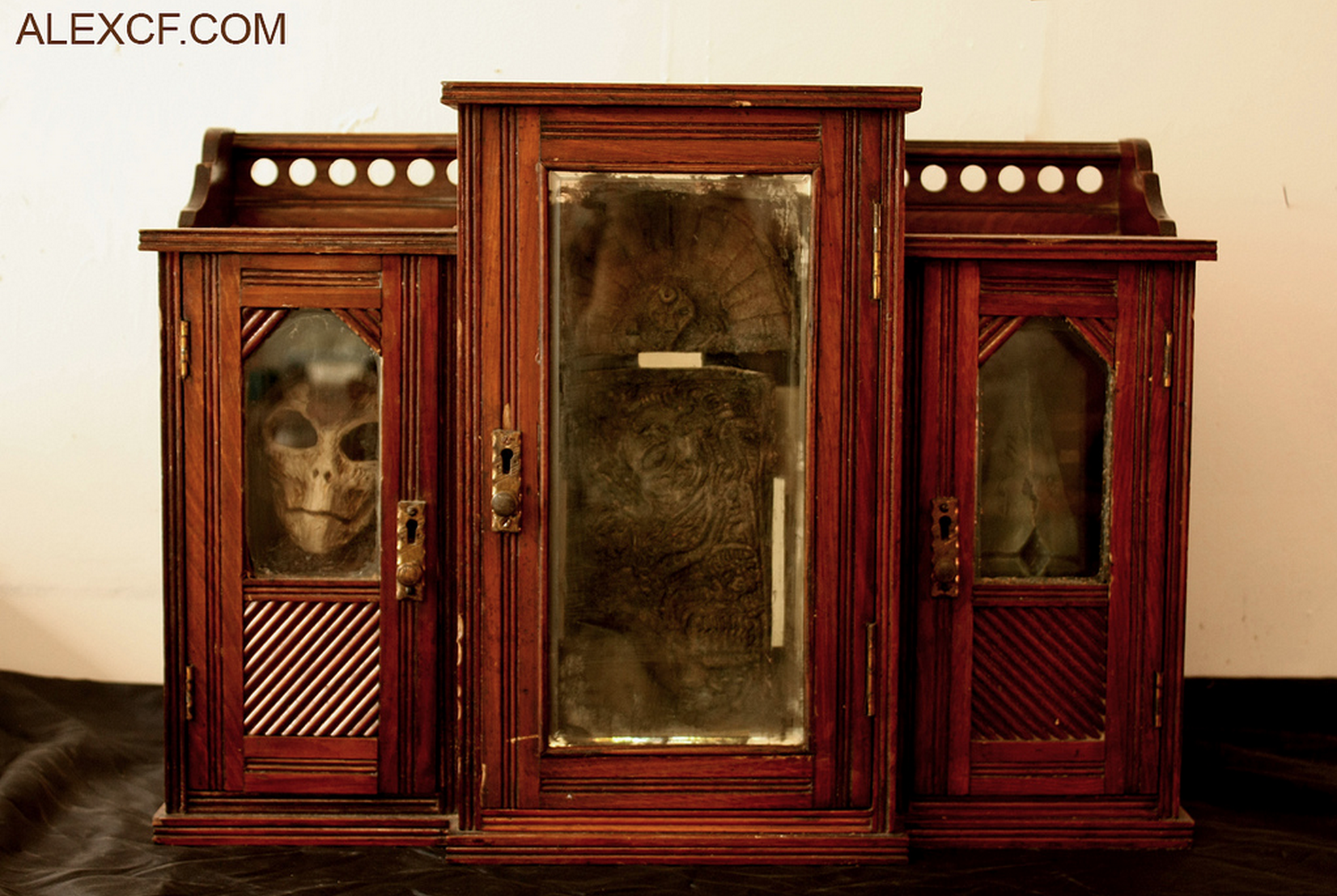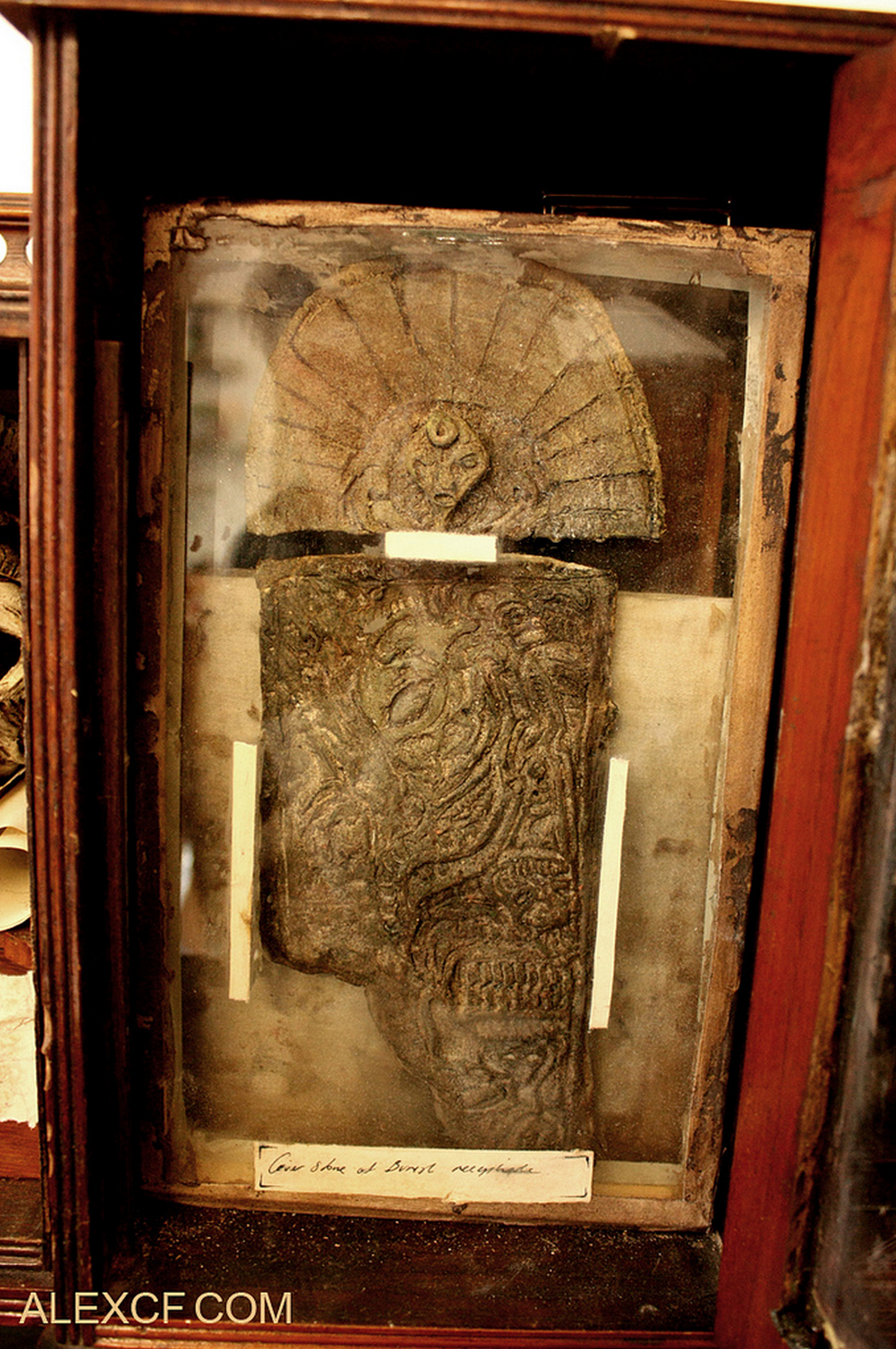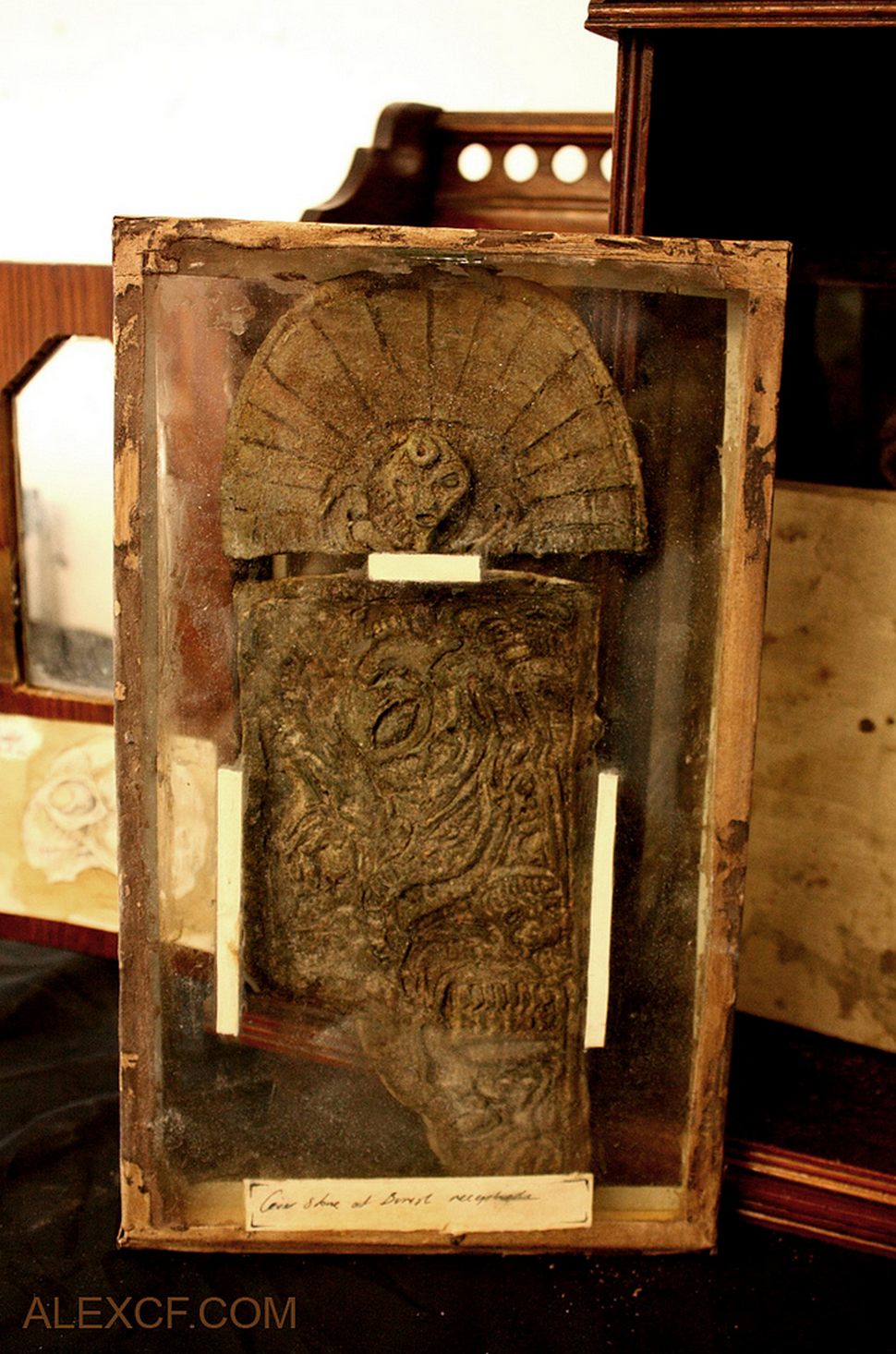All images copyright Alex CF 2014. Please credit and attach a link if used outside this website.
“A beautiful display cabinet containing bizarre and wondrous items of supposed extra terrestrial origin found within an early Mayan temple in the late 1900′s”
Therodan Stray was a 46 year old explorer who had risen to fame in the annals of the quarterly adventurer magazine ‘Young frontiersman”. This publication was loved by the American youth and was filled with adventure stories. in the 1880′s his expeditions to the wilds of Africa and steaming rain forests of the Amazon were the stuff of Legend, and what made it all so visceral and exciting was that it was all real. Therodan Stray spent years in the field, and would discover a great deal of the unexplored regions of the Earth. His smiling sun drenched face was placed besides indigenous tribesmen, holding the carcasses of strange and exotic creatures in fanciful illustrations.
But Therodan Stray had one obsession that few knew about. His great grandfather, Aloysius Stray, had known Edward Merrylin, Thomas’s father, and had served with him in the armed forces when Edward was a General. Aloysius had kept many diaries and had recorded much of his personal exploits with Edward, which took them across India and into China, in search of a mysterious object known as the Alabast. Aloysius would never see this object, as he returned home to England and eventually emigrated to America in the early 1900′s and establish his family there. Therodan would inherit these diaries from his Grandfather, Praetorius Stray, who read them to him over many dark evenings in front of the fireplace. It only dawned on Therodan the significance of the diaries, when Thomas Merrylin and his collection was bought into the limelight when he published a thesis on experimental physics which garnered much scrutiny by academics. Therodan was in his 20′s and studying chemistry and became fascinated with concepts which would baffle for many decades. Merrylin became his obsession.
Therodan Stray would invest a great deal of money into acquiring knowledge of forgotten cultures and when the writings and illustrations of Mayan ruins by traveler John Lloyd Stephens and Architect Frederick Catherwood reached his eager hands, he proposed multiple trips to South America and Mexico to investigate Mesoamerican archeology.He wrote to Merrylin on a number of occasions with enthusiasm and thanks for the inspiration. At the time, Merrylin never replied.
Therodan arrived in Belize and traveled east towards the Chiapas Highlands, where a number of Mayan sites could be found. He was accompanied by his colleague and friend, Patrick Waites, an archeologist whose main interest was in what would eventually be known as pre-classical Mayan architecture.
Sadly, two months into the trip, their chief guide fell ill with dysentery and they made camp a few hundred miles from the proposed final destination. They would stay here and continue research for weeks, with the guide becoming sicker with every day that passed. He soon died, and the team was left to fend for themselves. They kept to higher ground, with plenty of supplies. With high spirits, a plan was formulated to seek a path east.
The remaining guides were useful in finding safe trails and were loyal to their ward, and every morning would go off in search of interesting animal species and any sign of Mayan structural remains. They returned one morning with news of a site, higher into the hills, and soon the team trudged the few miles in the sweltering heat, until they reach a series greyish walls draped in undergrowth. From the outside it was not easy to discern which period, as the trees had consumed much of the structures, but Patrick eventually surmised it to be thousands of years old, taking into consideration style of stone work and the erosion on the rock itself.
The structure had a large central alcove that lead to a first floor chamber. The walls were scattered with disintegrating reliefs proving little use in identifying the purpose of the structure, but the space was sound, and they made camp so that Therodan and his colleagues could investigate further. They carried with them decent lamps, and descended into the bowels of the temple. Two huge stone plinths lay at the foot of a staircase, with what appeared to be bizarre geometric statues placed atop. The shapes were hard to discern, and had an almost metallic quality, which was very out of place within the stone edifice that surrounded it.
The walls displayed imagery that reminded Therodan of his travels in Egypt. Pictograms of gargoyle-like faces adorned with floral head dresses festooned various cartouche reliefs along the wall at eye height, priest like figures poised in worship, various images of stars above them, tales of sacrifice and of a time of plenty. They found a series of smaller objects scattered around the large metallic forms on the plinths which, although slightly corroded reminded Therodan of tools. As though someone had abandoned their work in a hurry. He took one of the objects, a 3 dimensional diamond which he later described as a “crude Octahedron”.
Beyond the first chamber was a second room, blocked by a large stone. Many hours were spent hauling the stone away, only to be faced by a further three large stones, some of which had been cut with such refinement that it seemed impossible to identify seam lines. Eventually they took to cutting the stone with pick axes. Four days of digging and they breached the chamber. They were greeted by a long passageway, the walls of which were a mixture of large stone work and more of the odd blue grey metallic material which now formed the walls. Piles of cut stone littered the floor, as though a task had been left unfinished. There was a resonance within the passage way, a hollow vibration when they spoke which seemed to suggest that this corridor was separate from the walls beyond it.
The corridor opened up into an oval room, before them a series of raised cuboids, arranged adjacent to one another, It was obvious to them all that this was a burial chamber. The floor was covered in small bundles of disintegrating cloth, and upon closer inspection, were identified as the remains of human bodies. They huddled around piles of jade offerings, jewellery and bizarre stone effigies. The chamber had a semi circle raised platform that descended to the floor, where one large and two smaller raised sarcophagi lay. beyond the largest a series of very small stone structures.
Patrick remarked that the cover stones appeared to have been added at a later time, the structure of the coffins consisting of a single piece of metal. Much of the stone work had been bought into the room and covered many of the metallic surfaces, carved to fit a very different aesthetic.
Therodan took rubbings of all of the cover stones, in case they were later damaged, and with care, they removed the largest. Within the sarcophagus was a peculiar sight. The space itself was not typical of most burials. The body was covered in a series of layers of a silk like cloth. Protruding from the walls of the coffin were various apparatus, bizarre symmetrical clamps held the body in place, and moved on pivots. Once released from these they could pull back the coverings. They were faced with something quite extraordinary.
It was a remarkable form, the body was small, perhaps four feet in height, although much shrunken during mummification. The head was enlarged, a bulbous cranium which appeared far too weighty for its fragile body. What was most striking were the facial features. The eye sockets were huge, and although the eyes themselves had long disintegrated, it was obvious that the sockets were many times larger than the average human and peculiarly almond shaped. The mouth and nasal cavities were similarly out of proportion. Much of the skin was intact, and covered the bone, but it was clear that the nasal cavities were disfigured, with no obvious septum, with two tiny openings for nostrils. The mouth was squat, almost impossible for speech.
The body seemed disproportionate, the sternum and rib cage fused in places and opened up with irregular honey comb like structures under the skin. The skin itself was very pale, incredibly tight to the bone with no sign of musculature, but a webbing like material that was still elastic, even in this state of ossification.
It had humanoid hands and feet, with regular amounts of digits. The graves that flanked the largest had similar bodies, but much smaller, child like in comparison to the first, yet these were not dressed in the silken robe, but in distinctly Mayan burial clothing, both wore head dresses and their skin had long since perished, leaving nothing but bone, as though they had died long before the first, leaving corpses whose osteology was unknown to any who now witnessed them.
The final smaller sarcophagi contained tiny fetal infants, remarkably well preserved, all bound in the remains of cloth and some dried tree bark. These tiny creatures were different in many ways from the larger. Although distinctly brittle and a little misshapen, their skeletal remains appeared recognisably human, a visible rib cage through taught skin identified this, yet the face still sported the enlarged eyes and tiny mouth.
They collected many specimens and took many samples. They spent days within the chambers making sense of what they found. Therodan returned to the statues atop the plinths in the tertiary chamber and with closer inspection found that they were composed of multiple parts, complex and beyond his understanding, it appeared that these were not plinths for displaying statues, but work surfaces and that the scattered objects were indeed tools. He found that the Octahedron fit into a space within the mechanism that sat atop the plinth and although entirely inert, knew that this had once been a functioning device of some sort. The room had been built and decorated by other hands, hands that had admired or in fact deified those who required space to work on these fabrications.
Therodan recorded this diary entry, which leaves us to ponder their discovery,
“After days of exploring and recording as much of the space as we could, we came together on the stair case and collapsed in exhaustion and disbelief. We all felt compelled to talk, but the words failed us. It was as though we had somehow walked into a house that had been vacated by its occupants mere moments before and we were here to piece together what had happened. There are carvings that offer some degree of explanation, although vague, tell a tale that beggars belief. Suffice to say we had all dreamed up an outlandish hypothesis.
The stone representations allude to one of their sacred astrological stars falling upon the earth, and those who dwelled in the star being taken from it, and given food and shelter. They were sick and wounded and whilst they recuperated the people used their construction skills to drag the great pieces of the star to their temple. Our guides call this people the Yana, which is the name given to a plant which grows a single flower amidst a sea of green- a splintered group of Maya who found home in these mountains, separated from those who would build the communities at Nakbe and Cival.
The “star” – a foreign construction of metal had been bought here in sections, large sections of a light weight alloy. Once its occupants had recovered they went about carefully reconstructing the object within the temple, and yet at some point this task had been abandoned, perhaps a collapse from above, or resignation by its owners that it was impossible. Other tasks had been formulated, Patrick hypothesised that the huge devices we mistook for art are a form of advanced combustion engine, which had been dismantled in hope of using them for some other purpose. This was also eventually abandoned. David has identified various pictorial representations of these wide eyed characters in a state of sadness, flanked by their worshipers, almost as though they are accepting a fate, that they would never leave here, and made their peace with their surroundings. They mixed with those who had worshiped them, even attempted union with them, yet the fruit of that ill fated task was now buried within the primary chamber. Perhaps the climate was cruel on their frail bodies, or unknown illness afflicted them, but soon they succumbed to the world they had fallen upon, the youngest dying first and the eldest, crawled into a chamber which may have aided its survival, and in time died.
The Yana mistook these life giving devices as graves, and interred those who had died before there, decorating each tomb with their own distinct aesthetic, each sarcophagus sealed with intricate and beautiful cover stones, depicting those that lay within. Some chose to seal themselves within the tomb alongside the bodies of their gods, and died in rapture.
Patrick is unsure how we will present this discovery to the scientific community, I feel that what we have found here is an isolated event, these visitors in their vehicle which traveled the heavens and crashed here millenia ago, presents many unanswerable questions. And could bring our reputations into disrepute. I dare say many will dismiss it entirely and those unscientific minds will make outlandish claims that these entities may have indeed influenced our human culture. We have chosen to take as much evidence as possible and return to Boston, where i shall once again attempt to contact Mr.Merrylin who i believe will be able to offer assistance in this case.”
Therodan returned to Boston four months later, with much of the evidence in his possession. He corresponded with a colleague of Merrylin who explained that he was currently on his own expedition in Nepal. The colleague suggested that the evidence be shipped to Merrylin where he could cast his knowledgeable eye over it and offer some assistance in this extraordinary conundrum. Therodan agreed, and the items were sent immediately to Merrylin House in Hellingshire, England. He would never see any of it again.
Merrylin did write a great deal about extra terrestrial life and found the awe and mystery of the concept rather tiring. Previous encounters with evidence of visitation was recorded on a number of his expeditions, yet this was the first physical evidence of mummified remains of these entities within the Americas he had encountered. From what he could gather, humans had been of interest to various non terrestrial species since we showed signs of burgeoning culture and society, and one particular species whose mark had been left on many prehistoric populations caught his attention. He called them the “short stubby children of the stars” and later “Denizens of Zeta Reticuli” when various depictions of the star constellation had appeared in the ruins of the Cawaka city of Mek, alongside glorious depictions of the almond eyed creatures. He considered them benevolent, extremely intelligent, yet messy, inefficient and disorganised in their study of us.
He could never tolerate mess.























